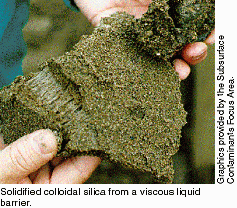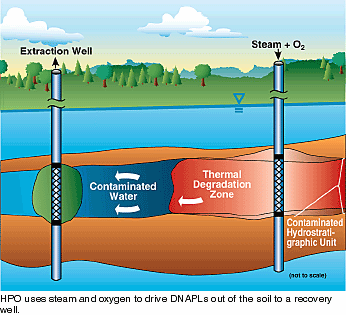About the
focus areas
The U.S. Department of Energy’s
Office of Environmental Management has established an
integrated approach for addressing waste issues based on
problem, or focus, areas. The focus areas are
deactivation and decommissioning; mixed waste
characterization, treatment, and disposal; plutonium;
radioactive tank waste remediation; and subsurface
contaminants. For several years, problems shared across
multiple focus areas were addressed by three crosscutting
programs—characterization, monitoring, and sensor
technology; efficient separations and processing; and
robotics technology development. In FY99, these programs
have been rolled into the focus areas.
The Subsurface Contaminants Focus Area
was formed in September 1996 with the merging of the
Contaminant Plumes Containment and Landfill Stabilization
focus areas. We have featured many individual
technologies funded by SCFA since we last spotlighted
this prolific program (Initiatives,
December 1996). In this issue
we catch up on program highlights and review a sample of
emerging SCFA technologies.
SCFA’s mission is to
develop, demonstrate, and deploy innovative systems that
contain and isolate leaking buried waste areas and that
remediate subsurface contamination including dense,
nonaqueous-phase liquids; metals; and radionuclides. The
challenge to SCFA technologies is formidable: more than
5,700 known DOE ground-water plumes have contaminated
more than 600 billion gallons of water and 200 million
cubic meters of soil, and DOE landfills contain more than
3 million cubic meters of buried waste. The solutions
fostered by SCFA reduce risks to health, safety, and the
environment and cut the costs of remediation while
meeting compliance requirements. In fiscal year 1998,
SCFA demonstrated ten technologies and deployed eight.
The focus area is organized into three
product lines based on major contaminants listed in
annual submission of site needs, stakeholder
expectations, and current technology development: source
term containment and remediation, DNAPLs remediation, and
metals and radionuclides remediation, each with its own
goal and implementation strategies.
Source Term
Containment
and Remediation Product Line
The goal of this product line is to
demonstrate containment of contamination sources that
pose imminent threats to surface and ground waters and
remediation of sources that pose continuing threats.
Remediation strategies include demonstrating systems to
identify and remove "hot spots" of buried
transuranic waste and in situ stabilization technologies
for landfill restoration as an alternative to retrieval
and ex situ waste treatment. Innovative containment
systems include alternative landfill covers, innovative
grout walls, and frozen and viscous liquid barriers.
- Frozen soil barriers artificially
reduce hydraulic conductivity and contain
contaminant plumes inside the boundaries of the
freeze. Consisting of multiple thermoprobes, an
active air-cooled refrigeration condensing unit,
a two-phase working fluid, an interconnecting
supply and return piping network, and a control
system, the system provides subsurface
containment for a variety of sites and wastes
including underground tanks, nuclear waste sites,
hazardous mixed waste sites, plume control,
burial trenches, and chemically contaminated
sites. It can be rapidly installed and removed,
is repairable in situ, uses benign materials, and
leaves no lasting effects. A demonstration system
installed at Oak Ridge National Laboratory in
1997 (see Initiatives, October/December
1997) employed 50
thermoprobes 6 inches in diameter, planted 6 feet
apart and 30 feet deep. Within 18 weeks, a
12-foot-thick barrier isolated nearly 170,000
cubic feet of soil and could be maintained with
less than $15 of electricity per day. Dye studies
established that the barrier achieved hydraulic
isolation from the surrounding area. The
technology is commercially available.

- Viscous liquid barriers use
permeation grouting to place inert liquids that
increase in viscosity over time. Using injection
from multiple points, an impermeable wall is
constructed without disturbing the soil matrix or
damaging structural features like tanks, pipes,
and cables. Materials such as colloidal silica
and polysiloxane are mixed with a brine solution
to design the material set time for emplacement.
This technology was successfully demonstrated at
Brookhaven National Laboratory.
DNAPLs
Product Line
DNAPL contamination in the subsurface is
difficult to locate and then remove in many hydrogeologic
settings. Robust treatment and extraction technologies
are required for remediation of DNAPLs in
difficult-to-treat, heterogeneous conditions. The goal of
the DNAPLs product line is to demonstrate the ability to
delineate DNAPL contamination in the subsurface and
remediate DNAPL-contaminated soils and ground water in
complex hydrogeologies. The following technologies
illustrate two strategies of the DNAPLs product line: to
adapt existing organic remediation technologies to
remediate DNAPL contamination—including passive,
biological, thermal, physical, and chemical treatment
methods—and to pursue innovative methods to
remediate DNAPLs in complex hydrogeologic settings that
are beyond the capabilities of technologies already under
development.

- In situ hydrous
pyrolysis/oxidation oxidizes DNAPLs through the
injection of steam and oxygen in contaminated
aquifers. When employed with pumped recovery, HPO
achieves both rapid mass removal of DNAPLs and in
situ destruction of residual contamination. It is
projected that these technologies may result in
significant cost savings by eliminating long-term
use of pump-and-treat methods. Deployed in a
full-scale cleanup of the Southern California
Edison telephone pole treatment yard in Visalia,
California, operations incorporating HPO
recovered 50,000 gallons of creosote in the first
six months, in contrast to 500 gallons per year
recovered by the baseline technology. In 22
months the technology recovered contaminants that
would have taken pump-and-treat methods 1400
years to recover. Naturally, Southern California
Edison plans to continue its use. Two California
firms are licensed to apply the technology
nationwide.
- Four technologies to remediate
DNAPLs in low-permeability media were
demonstrated side-by-side at the Portsmouth
Gaseous Diffusion Plant in 1997–98.
Horizontal fractures were generated in each test
cell using hydraulic fracturing techniques
developed in the oil industry. The fractures in
two cells were propped open with a sand slurry,
allowing access by steam and hot air. Another
cell used iron filings for a proppant, providing
in situ dechlorination; and fractures in the
final cell were propped open with potassium
permanganate grout, providing in situ oxidation.
The cell using potassium permanganate grout
produced the most promising results.
Both of these technologies are slated
for deployment at the Portsmouth Gaseous Diffusion Plant
in FY99.
Metals and
Radionuclides Product Line
The goal of the Metals and Rads product
line is to demonstrate the ability to mitigate a full
range of radionuclide and hazardous metal contamination
in soils and ground water. The following technologies
illustrate two strategies of this product line: to
develop, demonstrate, and deploy reactive permeable
barriers to cost-effectively remediate radionuclides and
hazardous metals and to develop a second generation of in
situ chemical treatment systems that bring together
advanced characterization and chemical treatment
technologies.
- Passive reactive barriers are
engineered structures emplaced in the subsurface
to capture and treat an advancing ground-water
contamination plume. The natural hydraulic
pressure gradient in the aquifer drives the plume
through the reactive zone to media designed
specifically for the site’s contaminant type
and concentration, background ground-water
chemistry, and cocontaminants. Designs include
impermeable barriers to funnel ground water
through in situ treatment gates and trenches
filled with permeable reactive media. Different
designs have been demonstrated at Rocky Flats
Environmental Technology Site and the Oak Ridge
Y-12 Plant. Initial results from both
installations indicate that the technology is
removing contaminants as expected. Through the
Accelerated Site Technology Deployment program, a
funnel-and-gate reactive barrier to remove
uranium from a ground-water plume will be
installed in FY99 at the Monticello, Idaho
Uranium Mill Tailings Remedial Action site, and
Lawrence Livermore National Laboratory plans to
use a trench-design reactive barrier to contain a
trichloroethylene plume.
- In situ redox manipulation creates
a treatment zone in the subsurface for
remediation of redox-sensitive contaminants in
ground water, including chromate, uranium,
technetium, some chlorinated solvents, and some
explosive compounds. Aquifer sediments are
chemically manipulated (reduced) so that they
become the reactive media. This technology won a
1998 R&D 100 Award (see story on 1998
R&D Awards for more
on this technology).
The Subsurface Contaminants Focus
Area is on the Web at http://www.envnet.org/scfa.
|



